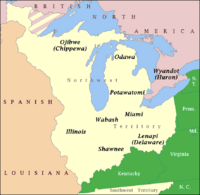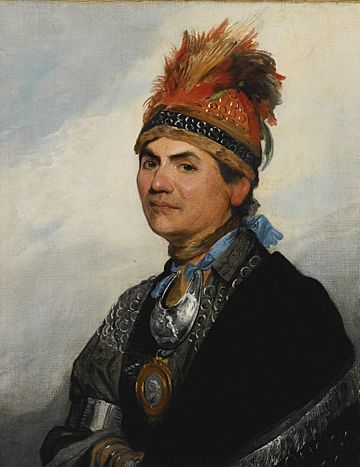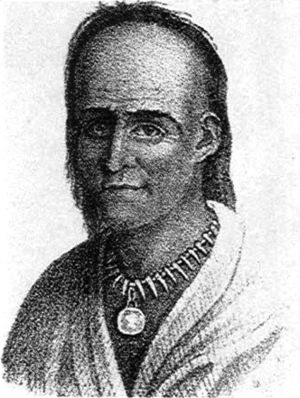Northwestern Confederacy facts for kids
Quick facts for kids Northwestern Confederacy |
|
|---|---|

Native nations of the Northwest Territory
|
|
| Also known as | United Indian Nations |
| Leaders |
|
| Dates of operation | 1783–1795 |
| Battles and wars | Northwest Indian War |
|
|
|
The Northwestern Confederacy was a group of Native American nations in the Great Lakes region of the United States. They came together after the American Revolutionary War (1775-1783). This group was also known as the United Indian Nations. Sometimes, people called it the Miami Confederacy because they thought the Miami tribes were the strongest.
This confederacy formed to stop the United States from expanding its settlements. After Great Britain gave the Northwest Territory to the U.S. in 1783, American settlers began moving into these lands. This led to the Northwest Indian War (1785–1795). The Confederacy won some big battles, but the war ended with a U.S. victory at the Battle of Fallen Timbers. The group then broke apart. Later, a new Native American resistance movement was started by Tenskwatawa and his brother, Tecumseh.
Contents
Why the Confederacy Formed
The land in the Ohio Country and Illinois Country had been fought over for a long time. Different Native American tribes and European powers like France and Britain wanted control. The French and Indian War (1754-1763) was the last big fight between Britain and France for this land. Britain won, and France gave its lands in North America to Britain.
After this, many Native American groups, including those who would later join the Northwestern Confederacy, fought against British rule in Pontiac's War (1763-1766). This war ended with a peace treaty.
In 1768, Britain made a treaty with its Iroquois allies. This treaty gave Britain control over lands south of the Ohio River. This led to many American colonists moving into these areas.
The Shawnee people were worried about losing their lands. They started asking settlers for money and formed alliances with other tribes. Early steps to create the Northwestern Confederacy happened in 1774. This was in response to events like the Yellow Creek massacre and Lord Dunmore's War.
Native Americans and the American Revolution
When the American Revolution began in 1775, Britain was fighting its American colonies. The British Army left some forts on the frontier. This made it easier for settlers to move onto Native American lands without permission.
Native Americans had different ideas about the war. Some saw it as a "white man's war" and wanted to stay out of it. Others saw a chance to protect their lands while the British and Americans fought each other. By 1776, there were warnings of a "General Confederacy of Western Tribes" planning to attack American settlers.
Many Native Americans fought alongside the British during the American Revolution. However, when the war ended in 1783, the British did not mention their Native American allies in the peace treaty. Joseph Brant, a Mohawk chief, felt the British had "sold the Indians to Congress."
Brant then worked to create a large Native American confederacy. This group could then negotiate with the new United States. In September 1783, leaders from 35 nations met. They decided that no agreements with the United States could be made without everyone in the confederation agreeing. The U.S. Congress recognized Native American land rights. However, they also claimed land and told Native nations to move beyond certain rivers.

Early Councils and Treaties
In August 1784, the council met again. U.S. representatives were supposed to meet them, but they were late. Many Native American leaders left before they arrived. The U.S. then met with the remaining Iroquois tribes. In the 1784 Treaty of Fort Stanwix, the Iroquois gave up their claims to Ohio lands. However, the Iroquois Confederacy said they had no right to give away those lands. The western nations living there also rejected the treaty.
In January 1785, the U.S. signed another treaty, the Treaty of Fort McIntosh. A few Native American representatives agreed to give the U.S. most of present-day Ohio. A small U.S. Army group arrived in the territory later that year.
In 1785, Joseph Brant traveled to Canada, London, and Paris to get support from the British and French. A council held that year decided that the confederacy would deal with the United States as one group. They also said that the Ohio River would be the border between their lands and American settlements.
However, some Shawnee, Lenape, and Wyandot leaders signed the 1786 Treaty of Fort Finney. This treaty allowed U.S. settlement north of the Ohio River. This led to more violence between Native Americans and settlers.
In September 1786, 35 Native nations rejected the Treaty of Fort Finney. They met and called themselves "the United Indian Nations, at their Confederate Council." They sent a letter to the U.S. Congress.
The U.S. appointed Arthur St. Clair as governor of the new Northwest Territory. He invited the nations to a council to make peace. At these meetings, Joseph Brant suggested a compromise. He said they could allow existing U.S. settlements north of the Ohio River. But some leaders disagreed. A Wyandot leader offered a peace belt to Little Turtle, a Miami military leader, who refused it. Brant then refused to negotiate with the U.S.
About 200 moderate leaders came to Fort Harmar in December 1788. They agreed to the 1789 Treaty of Fort Harmar. This treaty moved the border and gave the U.S. control over some Native lands. But to those who had refused to attend, this treaty did not solve their concerns about losing land.
Who Was Part of the Confederacy?
The groups in the confederacy changed over time. Not all villages or individuals from a nation always joined.
The nations who signed the 1786 letter to Congress included:
- The Iroquois (also called the "Six Nations")
- Cherokee
- Huron
- Shawnee
- Delaware
- Odawa
- Potawatomi
- Twitchee
- The Wabash Confederacy
Because they lived in or near the Ohio Country, the main tribes involved were:
- The Wyandot (or Huron): They hosted the first big meeting of Native nations.
- Shawnee
- Lenape (Delaware)
- Miami
- Council of Three Fires (Potawatomi, Odawa, and Ojibwe): Their southern groups were part of the Confederacy.
- The Wabash Confederacy (Wea, Piankashaw, and others): They were allies until they signed a separate treaty with the U.S. in 1792.
Other nations also supported the Confederacy, including:
- Sauk and Meskwaki
- Other Iroquois groups
- Members of the Seven Nations of Canada
- The Illinois Confederation
- Mingo
- Menominee
- Kickapoo
By 1790, the Confederacy had three main parts. The Iroquois wanted to talk things out with the U.S. The Three Fires wanted to resist, but they were further away from the U.S. threat. The Miami, Shawnee, and Kickapoo were directly threatened by U.S. settlements. They wanted a strong stand against the U.S.
War with the United States

In 1790, General Harmar led an army to defeat the Native confederacy. He marched north to Kekionga. His forces were defeated in what was a huge victory for Native Americans. This made the confederacy feel stronger. It was the first time Little Turtle and Shawnee leader Blue Jacket fought together.
The next year, General St. Clair led another army on the same path. The confederacy was meeting to discuss peace terms. But when they heard about the new army, they got ready for war. The confederacy surprised St. Clair's army in their camp. They quickly defeated them. This defeat was one of the worst in U.S. Army history.
After this big victory, U.S. President George Washington sent people to talk peace with the confederacy. However, these peace messengers were killed before they could reach the confederacy.
The confederacy kept debating whether to continue fighting or make peace while they had the advantage. In September 1792, a council of several nations met. They agreed that the Ohio River must remain the border for the United States. They also said that U.S. forts in the Ohio Country must be destroyed. They planned to meet with the U.S. again in 1793. The U.S. agreed to send commissioners and stop fighting until then.
At the 1793 council, the Shawnee and Delaware insisted that the U.S. recognize the 1768 treaty. This treaty set the Ohio River as a boundary. Joseph Brant disagreed. The U.S. commissioners said it would be too hard to move white settlers who had already built homes north of the Ohio River. The council sent a message to the U.S. They said the U.S. had no right to lands above the Ohio River. They suggested the U.S. use money to move white settlers instead of buying Native lands. The council ended without peace.
After the peace talks failed, a new U.S. army, called the Legion of the United States, marched north. This army was better trained and equipped. Its leader, General Anthony Wayne, built forts along the way to protect his supplies. The confederacy was divided on how to respond. Some leaders wanted to negotiate peace. The British, worried, sent more soldiers to Fort Miami. A large confederacy force attacked Fort Recovery. They caused many losses for the U.S. army. But this attack also showed disagreements within the confederacy.
On August 20, 1794, the U.S. Legion defeated the combined Native force at the Battle of Fallen Timbers. The British commander at nearby Fort Miami refused to help the Native forces. General Wayne then built a new U.S. fort, Fort Wayne, in Kekionga.
End of the Confederacy
The next year, the Northwestern Confederacy signed the Treaty of Greenville with the United States. This treaty forced the Native American tribes to give up lands in southern and eastern Ohio. They also gave up land around forts and settlements in Illinois Country. They had to recognize the United States as the main power in the Old Northwest. They also had to give up ten chiefs as hostages until all American prisoners were returned.
The Northwestern Confederacy stopped working as a single group. Many of its leaders promised peace with the United States. About ten years later, a new pan-Indian movement was started by Tecumseh. Historians say the Northwestern Confederacy was the strongest point of Native American resistance to white expansion.
Images for kids
-
The Glaize in 1792, showing towns of Little Turtle, Big Cat (home of war chief Buckongahelas), Captain Johnny, Blue Jacket, and Captain Snake, as well as Coocoochee's cabin.


